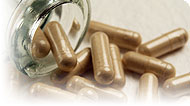Penn Herb Wellness Guide
CalciumFind Products

How to Use It
The National Academy of Sciences has established guidelines for calcium that are 2550% higher than previous recommendations. For ages 19 to 50, calcium intake is recommended to be 1,000 mg daily; for adults over age 51, the recommendation is 1,200 mg daily.1 The most common supplemental amount for adults is 8001,000 mg per day.2 General recommendations for higher daily intakes (1,2001,500 mg) usually include the calcium most people consume from their diets. Studies indicate the average daily amount of calcium consumed by Americans is about 5001,000 mg.
Where to Find It
Most dietary calcium comes from dairy products. The myth that calcium from dairy products is not absorbed is not supported by scientific research.3, 4 Other good sources include sardines, canned salmon, green leafy vegetables, and tofu.
Possible Deficiencies
Severe deficiency of either calcium or vitamin D leads to a condition called rickets in children and osteomalacia in adults. Since vitamin D is required for calcium absorption, people with conditions causing vitamin D deficiency (e.g., pancreatic insufficiency) may develop a deficiency of calcium as well. Vegans (pure vegetarians), people with dark skin, those who live in northern latitudes, and people who stay indoors almost all the time are more likely to be vitamin D deficient than are other people. Vegans often eat less calcium and vitamin D than do other people. Most people eat well below the recommended amount of calcium. This lack of dietary calcium is thought to contribute to the risk of osteoporosis, particularly in white and Asian women.
Best Form to Take
Calcium carbonate is the most commonly used form of calcium in supplements. Contrary to popular belief, most research has indicated it is at least as well absorbed as calcium from milk. Although some research has shown that calcium citrate and calcium citrate malate are better absorbed than calcium carbonate, other research has found that calcium carbonate is absorbed at least as well as calcium citrate, calcium citrate malate, calcium lactate, calcium gluconate, and oyster shell calcium, and that it is significantly more bioavailable than calcium phosphate. At this time, there is no conclusive evidence indicating that one form is preferable to another. However, people with hypochlorhydria have difficulty absorbing calcium carbonate, unless it’s taken with food.5
Another important issue when selecting a calcium supplement is tablet dissolution. Some tablets (not capsules or liquid preparations) do not dissolve well in the stomach, resulting in poor absorbability. In addition, some bone meal, dolomite, and oyster shell preparations have been found to contain significant amounts of lead or aluminum.6
Copyright 2025 TraceGains, Inc. All rights reserved.
Learn more about TraceGains, the company.
The information presented by TraceGains is for informational purposes only. It is based on scientific studies (human, animal, or in vitro), clinical experience, or traditional usage as cited in each article. The results reported may not necessarily occur in all individuals. Self-treatment is not recommended for life-threatening conditions that require medical treatment under a doctor's care. For many of the conditions discussed, treatment with prescription or over the counter medication is also available. Consult your doctor, practitioner, and/or pharmacist for any health problem and before using any supplements or before making any changes in prescribed medications. Information expires December 2025.


